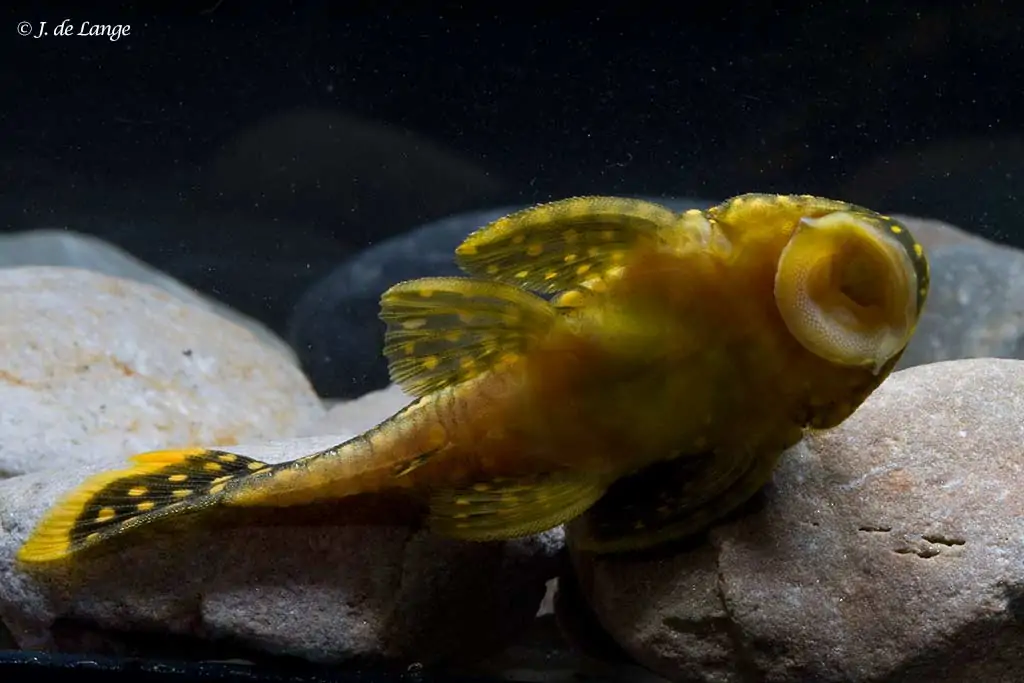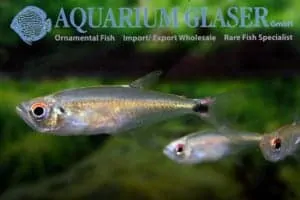Baryancistrus xanthellus – Golden Nugget
Baryancistrus xanthellus was officially described in 2011 by Rapp Py-Daniel, Zuanon & R. R. de Oliveira.
Before it was described, the species was given a temporary L number. After being officially described, the L number expires, but many websites and shops continue to use the numbers anyway. You can read more about the numbering in the article: L-Numbers and LDA Nummers? The explanation!
The Golden Nugget is divided into 3 different L-numbers, all from the Rio Xingu and Rio Iriri in the tropical rainforests of Brazil:
- The L018 has medium-sized yellow spots and comes from the Rio Xingu
- The L081 has small yellow spots and comes from the Rio Xingu – !!!This variant was NOT included in the study. It may turn out later that it is a Baryancistrus xanthellus after all, but for the time being this variant will keep its L number!!!
- The L085 was initially mistaken for a separate species, but upon further investigation it turned out to be an adult specimen of an L018
- The L0177 has large yellow spots and comes from the Rio Iriri

Description
The Golden Nugget is described on some sites as an algae eater, but this is not entirely correct. With its suction mouth, which is studded with small teeth, it scrapes through the aufwuchs. This aufwuchs not only consists of a layer of algae, but also contains crustaceans, small insects, insect eggs, insect larvae, plankton and freshwater sponges. At the same time as the aufwuchs, the Golden Nugget also gets some wood scrapings inside. In the aquarium it must therefore be fed with a variety of food, mainly vegetable food with occasionally frozen food. Driftwood should also not be missing. The wood fibers keep its digestion going.
Golden Nuggets usually leave other species completely alone and are therefore suitable for a community aquarium. However, keep in mind that they are nocturnal. It is therefore best to feed them a little extra when the lights are off. As long as it is light, they hardly or never come out of their hiding place. They usually choose the dark side of a piece of wood as their habitat. To be able to see this fish, I turned the wood in my aquarium around as soon as it had chosen a permanent spot.
These Baryancistrus can be very aggressive with each other. In an aquarium that is too small, even to death. Only in a large aquarium with an abundance of hiding places can several specimens be kept together.
Origin
South America: Rio Xingú near Altamira, Pará, Brazil.
The Aquarium
This quite large catfish prefers a dimly lit aquarium with plenty of hiding places, in the form of plants, driftwood, rocks and/or artificial caves. To keep several specimens of this species, or to keep this species together with other bottom dwellers, an aquarium of 120×50 centimeters is required, as the species can be quite territorial.
In the absence of suitable hiding places or insufficient space, the Gold Nugget Pleco can behave particularly aggressively towards other bottom dwellers. If it is the only bottom dweller in the aquarium, an aquarium of 100×40 centimeters is more than sufficient. Juveniles can be kept temporarily in smaller aquariums without any problems, as long as there are sufficient hiding places. A strong filter is important, as this fish produces a lot of waste due to its almost insatiable hunger.
Although this species is an adaptable and strong fish once acclimatized, it, like most other Baryancistrus species, often does not grow or grows only very slowly. This can be explained by the fact that in most cases the behavior in captivity does not occur under natural conditions. In the wild they can reach a length of more than 30 centimeters.
The Gold Nugget Pleco naturally occurs in shallow water, often strongly heated by direct sunlight, with a lot of current and a high oxygen content. Under these conditions, the stones and pebbles between which this species is found are more or less permanently overgrown with an organic layer consisting of plant and animal components (“Aufwuchs”). The high water temperature ensures a fast metabolism, with the result that these animals spend a very large part of the day looking for food. It is therefore not surprising that this kind of (not easy to reproduce!) conditions are required to achieve a natural attitude (and growth), and that this fish is especially suitable for a special aquarium.
Breeding Baryancistrus xanthellus – Golden Nugget
Breeding of this species has been problematic for years. Different water compositions and temperatures did not produce successful repeating spawns. The key to successful breeding seems to lie in the current. Point the outlet of the filter at the entrance of the breeding cave and the chance that they will start breeding becomes very high, of course temperatures and water values must be in the right direction.
Comments
Baryancistrus species are notorious for the difficulty of acclimatization: a significant proportion – over 50% in some species – of imported specimens from this genus die during the first month in captivity due to stress and malnutrition. Another problem of recently imported specimens is the deterioration of the intestinal bacterial flora, which has been disrupted by transport (resulting in digestive problems and a strongly reduced absorption of extremely important nutrients, especially during the first weeks). Fish offered in stores must have been quarantined at the importer/trader for a minimum of several weeks to ensure reasonable survival rates. This is not the case with fish with sunken eyes and abdomen, and unfortunately, more often than not, the animals will die within a few weeks.
Once home, this fish should be kept in a quarantine aquarium for a number of weeks to allow the animal to get used to life in captivity and the local water values. During this period it should also be checked whether the armored catfish eats well: in the aquarium – depending on the food offered – red to dark brown colored thin, solid strings of feces (also called spaghettis by hobbyists) can be found, as a sign that it eats the food. In addition, it can be determined which types of food are accepted and which are not. Once the fish is eating well, is active and alert, and looks healthy (good coloring, bulging belly, slightly bulging, clear eyes), it can be transferred to a larger tank.
But the problems don’t end there: no matter how vulnerable Baryancistrus species are during the first few weeks, once acclimatized it is often a completely different story. Once the fish has become accustomed to its new environment, it will claim a territory and defend it against intruders. Congeners in particular are not tolerated, but other bottom dwellers can also have a hard time. Fights can be quite fierce, and in some cases (as was – unfortunately – the case with one of my Gold Nuggets) it is advisable to separate the fish to avoid unnecessary stress and injury. But with the help of sufficient hiding places and breaking sight lines, the territory problem can usually be solved without the need to move one or more fish.
Video
Authors
Jonas Hansel – Piranha-info.com
John de Lange
Copyright images
Gert Jan van Beek
John de Lange
Ben Lee – Amiidae.com


























Reviews
There are no reviews yet.